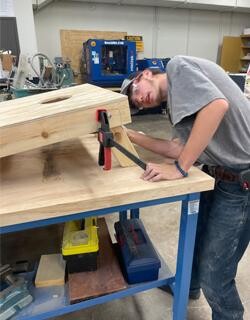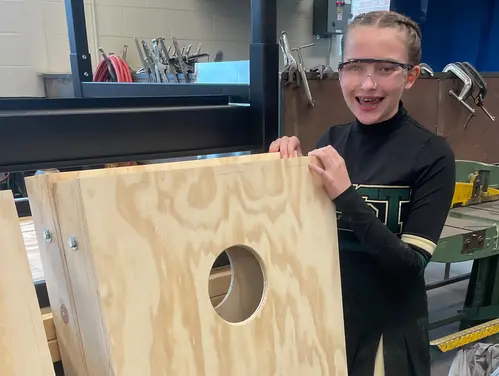If an algebra or geometry teacher got a nickel for every time they heard, “I’m never going to use this,” they probably could retire early – and in style.
But several mathematics teachers in the state are deploying a different approach, incorporating contextualized learning that makes algebra and geometry refreshingly relevant and interesting.
It all started when Emily Logan and her colleague Sara Whitt at Grant Wood Area Education Agency were challenged to come up with a better way to deliver algebra and geometry, both of which have had bad reputations for generations.
“Algebra 1, for instance, has a reputation of being a class to fail and that’s really bad considering it is the gateway to higher-level mathematics,” Logan said. “The real challenge here is, ‘can we get kids interested in algebra 1?’”
After teaching high school mathematics for 15 years, Logan knows well the challenges teachers face. So when she was given the challenge at the AEA, she embraced it. After doing some research, she targeted coursework on contextualized learning being taught in Colorado with an emphasis on algebra, or Amped on Algebra, and geometry, called Geometry in Construction.
Logan attended the algebra course while Whitt attended the geometry course.
“Within the first four hours, we looked at each other and said, ‘this is amazing,’” Logan said. “We knew we had found what we were looking for: Courses that put high-level math into hands-on, real-world projects.”

Logan and Whitt went back to Grant Wood hyped on the possibilities. When she got the green light to proceed, she didn’t waste time. In the summer of 2022, the first round of trainings took place. Teachers from Benton, Alburnett, Cedar Rapids, Center Point-Urbana, Iowa City, Marion, North Linn, Tipton and Williamsburg took part in the training.
And make no mistake: This is not watered-down versions of algebra and geometry.
“This is not a dummied-down version,” she said. “It isn’t applied math or middle school math. It was absolutely algebra 1 and geometry with a different approach.”
The courses boil down to this: Algebra teachers team up with business teachers, and geometry teachers team up with construction teachers. There can be some variation of the pairings to include other disciplines such as agriculture.
In order to be successful, it requires two classes back to back – the mathematics course followed by a construction or business course.
“The reality is that we are together for those two periods and it is a block of time,” Logan said. “Ideally you have 40 to 50 students in a class and you manage the kids collectively. It is a way to make it fit in a system that already exists without upsetting many apple carts.”
Not all schools that are pursuing this have incorporated both algebra and geometry courses.
“Some are doing one or the other,” Logan said. “Schools have struggled with Amped on Algebra because some students take algebra I in middle school so it is hard to offer it for all students.”
April Pforts, a mathematics consultant for the Iowa Department of Education, is impressed with the work the schools are doing.
“Students engaging in mathematical problem solving and communicating reasoning in a context
that is in an area of interest is a great strategy to re-engage students in higher-order thinking about mathematics concepts,” she said.
The Iowa City Community School District’s Iowa City and West high schools began offering Geometry in Construction this fall. West High mathematics teacher Julie Kennebeck is enthusiastic about Geometry in Construction.
“It’s been my experience that students have always had a perception of algebra and geometry like ‘what am I going to do with it?’” she said. “This new approach shows how it can be used, and gives them real-world experiences. They develop critical-thinking skills all the while getting a big-picture of the work.”
West High continues to offer traditional geometry in addition to Geometry in Construction. Kennebeck said she finds the enthusiasm in the latter class palpable.
“I teach regular geometry, too, and it is a night-and-day difference,” she said. “I can sense in my regular class that they are thinking ‘what is the point of this, when am I going to use this?’
“As for the Geometry in Construction, never did they ask why they needed to know this. There is genuine enthusiasm.”
Kennebeck co-teaches the class with the construction teacher.
“While we’re teaching geometry, it is more about discovery among the students,” she said. “They have to apply critical thinking in their work. And from there, they need to apply geometry to get their work done.”
A recent project was making a game that some call the cornhole bag game, in which you toss bags a distance and try to get it to land in a hole on a propped-up board.
“We talk about measurements as we go along and how to find the centers of the boards,” she said. “They need to determine the angles of the legs and where they need to place the legs. The kids had to research how to make the bag boards. They drafted the boards using fractions, finding the center and all the other work. The kids were excited to get into the shop and do the building.”
The class has since moved onto building balsa wood houses using scaled drawings.
“They talk about going from a floor plan and making mathematical conversions,” Kennebeck said. “The focus on how much balsa they need without wasting any material is important. It's definitely a real-world approach.”
After the balsa wood houses, the students will move to building raised-planter beds and a picnic table that converts to a bench, something a district elementary school has requested.
Ostensibly, Kennebeck envisions the program being self-sustaining by selling products they make and using the money to pay for materials.
“Create products that your public wants and needs,” she said. “This is our futuristic goal. We want to help the community and have our students learn along the way.”
Extending the program to the community is precisely what will make the mathematics classes mirror the real world and create excitement among students, Logan said.
“We ask schools to think about what they have going on either in school or locally,” she said. “Do you have a coffee shop? Do you have a school spirit store? They could be the focus of mathematics work.”
One school district is manufacturing and selling things like keychains.
“It depends upon where the strengths of the district are,” Logan said. “You have to think, ‘what do we have going on in our community? In our school?’ Look for that low-hanging fruit to get the business off the ground. By year two, you will be expanding it quite a bit.”
Logan’s daughter, who attends the Marion Independent School District, is involved in Amped on Algebra. Her daughter’s class is working to market customized notepads that they construct in class. The construction, of course, incorporates real-world business skills. But it goes beyond that.
“My daughter had to write a professional email asking for business from a client,” Logan said. “She said, ‘mom, I need you to read the email to make sure it is really professional.’ Two days later, she had to meet with the teacher personally.
“They are getting so much more than just the algebra content. They are learning how to handle themselves, how they talk about their products. It is incredible watching those students transform themselves.”
The contextual mathematics classes have caught the attention of other schools, with another dozen-or-so high schools from across the state learning about the courses this past summer.
Since the contextual mathematics classes are in their first year, it’s too early to say whether those taking these classes do as well as – or better – than the students who are taking traditional algebra and geometry courses. But, anecdotally, Logan likes what she sees.
“The enthusiasm alone is incredible,” she said. “I have never seen enthusiasm for algebra and geometry on this level. I have heard from educators that students in these courses are performing better than the traditional classes. I can’t wait to see how the data looks in the coming years.”
